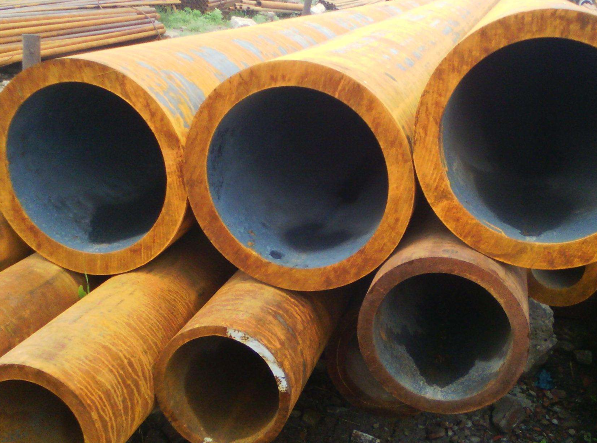
Hot-rolled carbon steel pipes are divided into general steel pipes, low and medium pressure boiler steel pipes, high pressure boiler steel pipes, alloy steel pipes, stainless steel pipes, petroleum cracking pipes, geological steel pipes and other steel pipes.

General carbon steel pipe: It is made of 10, 20, 30, 35, 45 and other high-quality carbon steel 16Mn, 5MnV and other low-alloy structural steel or 40Cr, 30CrMnSi, 45Mn2, 40MnB and other alloy steel hot-rolled or cold-rolled. Seamless pipes made of low carbon steel such as 10 and 20 are mainly used for fluid transportation pipelines. 45, 40Cr and other medium carbon steel seamless pipes are used to manufacture mechanical parts, such as the stressed parts of automobiles and tractors. Generally, carbon steel pipes are used to ensure the strength and flattening test. Hot-rolled steel pipes are delivered in a hot-rolled state or heat-treated state; cold-rolled steel pipes are delivered in a heat-treated state.
Due to the durability and shock resistance of carbon steel, pipes made from this material are not affected by environmental conditions such as pressure or extreme weather. This makes it an ideal material for structural piping applications, such as those laid under roads. Pipes can be made thinner while still carrying large volumes of corrosive materials. Carbon steel pipes are also safe for the environment, as approximately 50% of the world's steel is made from recycled materials.
Main performance characteristics:
1. Good mechanical properties
Carbon steel has good tensile strength, bending strength and high hardness, and is suitable for manufacturing various mechanical components, load-bearing structures and automotive parts.
2. Relatively low price
Compared with stainless steel, copper, aluminum and other materials, carbon steel is relatively cheap and has mature production technology. It is the most economical type of steel pipe.
3. Easy to process
Carbon steel has good processing performance and is easy to drill, mill, turn, weld, bend, cut and other processing, which can meet the needs of various processing technologies. Mechanical properties can also be adjusted by cold drawing/hot rolling.
4. High temperature resistance
Ordinary carbon steel pipes, without special treatment, can usually be safely used in the temperature range of -40°C to 450°C, suitable for boilers and heat exchangers. This range meets the needs of most industrial applications.
However, when the ambient temperature exceeds this range, the performance of carbon steel pipes may be affected. At extremely low temperatures, steel pipes may become brittle and prone to breakage; in high temperature environments, the mechanical properties of steel pipes may decrease, and even deform or break.
For every 100°C increase in temperature, the tensile strength decreases by about 15%~20%.
The oxidation rate of unprotected carbon steel at 500°C is 0.1~0.5mm/year.
5. Wide applicability
Corrosion resistance can be improved through galvanizing, plastic coating and other treatments to adapt to a variety of environments.
Disadvantages of carbon steel pipes:
1. Easy to rust
Carbon steel pipes are prone to rust in humid, acidic and alkaline environments, affecting service life and appearance.
2. Poor corrosion resistance
Carbon steel pipes have poor corrosion resistance and are highly corrosive to chemicals, water and other corrosive substances. Additional anti-corrosion treatment is required to increase service life (such as galvanizing, epoxy coating).
3. Easy to produce local defects
Carbon steel pipes are prone to local defects during production and use due to various reasons, which will affect the strength and service life of the pipes. Strict acceptance inspection should be done during procurement.
4. Low temperature brittleness
Toughness decreases at low temperatures (<-20℃), and low temperature carbon steel (such as ASTM A333 Gr.6) needs to be used instead.
5. Heavy weight
Carbon steel pipes have a high density (7.85g/cm³), are heavier than aluminum alloy and plastic pipes, and have higher transportation and installation costs.
6. Poor aesthetics
The surface needs to be sprayed or plated before it can be used in decorative scenes (such as exposed pipes in buildings).
Applications of carbon steel pipes:
1. Construction and structural engineering
Scaffolding, support columns
Building frames, steel structure bridges
Water supply/drainage pipes
2. Petroleum and energy
Oil and gas pipelines
Boiler tubes, heat exchangers
Nuclear power conventional island pipelines
3. Machinery manufacturing
Hydraulic cylinders
Bearing sleeves, drive shafts
Automobile exhaust pipes
4. Municipal and agriculture
Fire protection pipelines
Irrigation systems
HVAC ducts
5. Special scenarios
Low-temperature pipelines (ASTM A333 Gr.6, for LNG)
Wear-resistant pipelines (NM360/NM400, for mine transportation)
Application differences between carbon steel pipes and ordinary steel pipes:
Carbon steel pipes:
Seamless carbon steel pipes: Petroleum, chemical high-pressure pipelines, mechanical parts (such as shafts).
Welded carbon steel pipes: Building structures, low-pressure fluid transportation (such as water, gas).
Ordinary steel pipes:
Scenarios with low strength requirements such as building supports and bridges.
When to choose carbon steel pipe?
Carbon steel pipe is preferred:
Budget is limited, strength requirements are high, and long-term corrosion resistance is not required (such as building structures, ordinary fluid transportation).
Avoid carbon steel pipe:
Highly corrosive environment (seawater, chemical acid and alkali), extremely low temperature/high temperature, food and medical and other scenes with high hygiene requirements.
Read more: Which is Better Seamless Pipe or Welded Pipe? or Carbon Steel Pipe Schedule Chart
